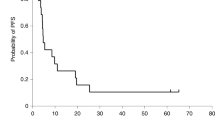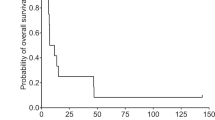Abstract
We have previously demonstrated with several cell lines in vitro that hydroxyurea (HU) synergistically enhances ganciclovir (GCV)-mediated cytotoxicity in bystander cells. In this study, we evaluated the role of DNA synthesis inhibition on enhanced bystander killing and assessed whether addition of HU would improve the efficacy of the HSV-TK/GCV system in vivo. Compared with GCV treatment alone, addition of HU resulted in increased DNA synthesis inhibition and delayed progression through S phase following removal of drug. In a xenograft tumor model, 1:10 and 1:1 mixtures of HSVtk- and LacZ-expressing SW620 cells were injected s.c. in the flanks of nude mice and treated i.p. (100 mg/kg GCV, 1500 mg/kg HU) daily for 5 days. Tumors from mice treated with GCV alone grew rapidly and increased to 10 times their initial size in 15.7 ± 1.8 and 16.0 ± 0.9 days for 1:10 and 1:1 mixtures, respectively. However, when both GCV and HU were administered in combination, a single complete tumor regression was observed in both the 1:10 and 1:1 groups. In the remaining mice treated with GCV/HU, it took 23.2 ± 2.1 (1:10) and 26.4 ± 3.8 days (1:1) to obtain a similar 10-fold increase in tumor size.
This is a preview of subscription content, access via your institution
Access options
Subscribe to this journal
Receive 12 print issues and online access
$259.00 per year
only $21.58 per issue
Buy this article
- Purchase on Springer Link
- Instant access to full article PDF
Prices may be subject to local taxes which are calculated during checkout





Similar content being viewed by others
References
Moolten FL . Tumor chemosensitivity conferred by inserted herpes thymidine kinase genes: paradigm for a prospective cancer control strategy Cancer Res 1986 46: 5276–5281
Balzarini J, Bohman C, DeClercq E . Differential metabolism of cytostatic of (E)-5-(2-bromovinyl)-2’-deoxyuridine, 9-(1,3-dihydroxy-2-propoxymethyl)guanine, and other antiherpetic drugs on tumor cells transfected by the thymidine kinase gene of herpes simplex virus type 1 or type 2 J Biol Chem 1993 269: 6332–6337
Ilsley DD, Lee S-H, Miller WH, Kuchta RD . Acyclic guanosine analogs inhibit DNA polymerases α, δ, and ɛ with very different potencies and have unique mechanisms of action Biochemistry 1995 34: 2504–2510
Ezzeddine ZD et al. Selective killing of glioma cells in culture and in vivo by retrovirus transfer of the herpes simplex virus thymidine kinase gene New Biol 1991 3: 608–614
DiMaio JM et al. Directed enzyme pro-drug gene therapy for pancreatic cancer in vivo Surgery 1994 116: 205–213
Caruso M et al. Regression of established macroscopic liver metastases after in situ transduction of a suicide gene Proc Natl Acad Sci USA 1993 90: 7024–7028
Ram Z et al. In situ retroviral-mediated gene transfer for the treatment of brain tumors in rats Cancer Res 1993 53: 83–88
Vile RG, Hart IR . Use of tissue-specific expression of the herpes simplex virus thymidine kinase gene to inhibit growth of established murine melanomas following direct intratumoral injection of DNA Cancer Res 1993 53: 3860–3864
O'Malley BW Jr, Chen S-H, Schwartz MR, Woo SLC . Adenovirus-mediated gene therapy for human head and neck squamous cell cancer in a nude mouse model Cancer Res 1995 55: 1080–1085
Yoshida K et al. Retrovirally transmitted gene therapy for gastric carcinoma using herpes simplex virus thymidine kinase gene Cancer 1995 75: 1467–1471
Roth JA, Cristiano RJ . Gene therapy for cancer: what have we done and where are we going? J Natl Cancer Inst 1997 89: 21–39
Freeman SM et al. The ‘bystander effect’: tumor regression when a fraction of the tumor mass is genetically modified Cancer Res 1993 53: 5274–5283
Denning C, Pitts JD . Bystander effects of different enzyme-prodrug systems for cancer gene therapy depend on different pathways for intercellular transfer of toxic metabolites, a factor that will govern clinical choice of appropriate regimes Hum Gene Ther 1997 8: 1825–1835
Boucher PD, Ruch RJ, Shewach DS . Differential ganciclovir-mediated cytotoxicity and bystander killing in human colon carcinoma cell lines expressing herpes simplex virus thymidine kinase Hum Gene Ther 1998 9: 801–814
Rubsam LZ, Davidson BL, Shewach DS . Superior cytotoxicity with ganciclovir compared with acyclovir and 1-B-D-arabinofuranosylthymine in herpes simplex virus-thymidine kinase-expressing cells: a novel paradigm for cell killing Cancer Res 1998 58: 3873–3882
Bi WL et al. In vitro evidence that metabolic cooperation is responsible for the bystander effect observed with HSVtk retroviral gene therapy Hum Gene Ther 1993 4: 725–731
Tourainem RL et al. The bystander effect in the HSVtk/ganciclovir system and its relation to gap junctional communication Gene Therapy 1998 5: 1705–1711
Ishii-Morita H et al. Mechanism of ‘bystander effect’ killing in the herpes simplex thymidine kinase gene therapy model of cancer treatment Gene Therapy 1997 4: 244–251
Sturtz FG et al. Variable efficiency of the thymidine kinase/ganciclovir system in human glioblastoma cell lines: Implications for gene therapy Hum Gene Ther 1997 8: 1945–1953
McMasters RA et al. Lack of bystander killing in herpes simplex virus thymidine kinase-transduced colon cell lines due to deficient connexin43 gap junction formation Hum Gene Ther 1998 9: 2253–2261
Yang L et al. Intercellular communication mediates the bystander effect during herpes simplex thymidine kinase/ganciclovir-based gene therapy of human gastrointestinal tumor cells Hum Gene Ther 1998 9: 719–728
Rubsam LZ et al. Cytotoxicity and accumulation of ganciclovir triphosphate in bystander cells cocultured with herpes simplex virus type 1 thymidine kinase-expressing human glioblastoma cells Cancer Res 1999 59: 669–675
Sterman DH et al. Adenovirus-mediated herpes simplex virus thymidine kinase/ganciclovir gene therapy in patients with localized malignancy: results of a phase I clinical trial in malignant mesothelioma Hum Gene Ther 1998 9: 1083–1092
Boucher PD, Ostruska LJ, Shewach DS . Synergistic enhancement of herpes simplex virus thymidine kinase/ganciclovir-mediated cytotoxicity by hydroxyurea Cancer Res 2000 60: 1631–1636
Sheaff R, Ilsley D, Kuchta R . Mechanism of DNA polymerase α inhibition by aphidicolin Biochemistry 1991 30: 8590–8597
Gwilt PR, Tracewell WG . Pharmacokinetics and pharmacodynamics of hydroxyurea Clin Pharmacokinet 1998 34: 347–358
Donehower RC . Hydroxyurea Chabner BA, Longo DL (eds); Cancer Chemotherapy and Biotherapy Lippincott-Raven 1996 pp 253–261
Van Den Berg CL et al. Pharmacokinetics of hydroxyurea in nude mice Anti-Cancer Drugs 1994 5: 573–578
Mayhew CN et al. In vivo and in vitro comparison of the short-term hematopoietic toxicity between hydroxyurea and trimidox or didox, novel ribonucleotide reductase inhibitors with potential anti-HIV-1 activity Stem Cells 1999 17: 345–356
Collins A, Oates DJ . Hydroxyurea: effects on deoxyribonucleotide pool sizes correlated with effects on DNA repair in mammalian cells Eur J Biochem 1987 169: 299–305
Yoshioka A et al. Deoxyribonucleoside triphosphate imbalance J Biol Chem 1987 262: 8235–8241
Wadler S, Horowitz R, Zhang H, Schwartz EL . Effects of perturbations of pools of deoxyribonucleoside triphosphates on expression of ribonucleotide reductase, a G1/S transition state enzyme, in p53-mutated cells Biochem Pharmacol 1998 55: 1353–1360
Spadari S et al. Control of cell division by aphidicolin without adverse effects upon resting cells Drug Res 1985 35: 1108–1116
Matherly LH, Schuetz JD, Westin E, Goldman ID . A method for sychronization of cultured cells with aphidicolin:application to the large-scale synchronization of L1210 cells and the study of the cell cycle regulation of thymidylate sythase and dihydrofolate reductase Anal Biochem 1989 182: 338–345
Boucher PD, Shewach DS . Synergistic enhancement of HSV-TK/ganciclovir bystander killing by hydroxyurea Proc Am Assoc Cancer Res 1998 39: 351
Boucher PD, Shewach DS . Gemcitabine synergistically enhances ganciclovir-mediated cytotoxicity in bystander cells Proc Am Assoc Cancer Res 2001 4: 2
Trosko JE, Ruch RJ . Cell–cell communication in carcinogenesis Front Biosci 1998 3: D208–D236
Mesnil M et al. Bystander killing of cancer cells by herpes simplex virus thymidine kinas gene is mediated by connexins Proc Natl Acad Sci USA 1996 93: 1831–1835
Elshami AA et al. Gap junctions play a role in the ‘bystander effect’ of the herpes simplex virus thymidine kinase/ganciclovir system in vitro Gene Therapy 1996 3: 85–92
Mullen CA, Kilstrup M, Blaese RM . Transfer of the bacterial gene for cytosine deaminase to mammalian cells confers lethal sensitivity to 5-fluorocytosine: a negative selection system Proc Natl Acad Sci USA 1992 89: 33–37
Rogulski KR, Kim JH, Kim SH, Freytag SO . Glioma cells transduced with an Escherichia coli CD/HSV-1 TK fusion gene exhibit enhanced metabolic suicide and radiosensitivity Hum Gene Ther 1997 8: 73–85
Aghi M et al. Synergistic anticancer effects of ganciclovir/thymidine kinase and 5-fluorocytosine/cytosine deaminase gene therapies J Natl Cancer Inst 1998 90: 370–380
Ostruszka LJ, Shewach DS . The role of cell cycle progression in radiosensitization by 2’,2’-difluoro-2’-deoxycytidine Cancer Res 2000 60: 6080–6088
Dethlefsen LA, Prewitt JMS, Mendelsohn ML . Analysis of tumor growth curves J Natl Cancer Inst 1968 40: 389–405
Carlsson G, Gullberg B, Hafstrom L . Estimation of liver tumor volume using different formulas. An experimental study in rats J Cancer Res Clin Oncol 1983 105: 20–23
Acknowledgements
This work was supported in part through an AACR-Amgen Inc. Research Fellowship in Translational Research and grants CA76581 and CA72217 from the National Cancer Institute.
Author information
Authors and Affiliations
Rights and permissions
About this article
Cite this article
Boucher, P., Ostruszka, L., Murphy, P. et al. Hydroxyurea significantly enhances tumor growth delay in vivo with herpes simplex virus thymidine kinase/ganciclovir gene therapy. Gene Ther 9, 1023–1030 (2002). https://doi.org/10.1038/sj.gt.3301730
Received:
Accepted:
Published:
Issue Date:
DOI: https://doi.org/10.1038/sj.gt.3301730
Keywords
This article is cited by
-
MLH1 deficiency enhances tumor cell sensitivity to ganciclovir
Cancer Gene Therapy (2009)
-
GCV phosphates are transferred between HeLa cells despite lack of bystander cytotoxicity
Gene Therapy (2005)



